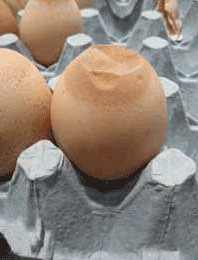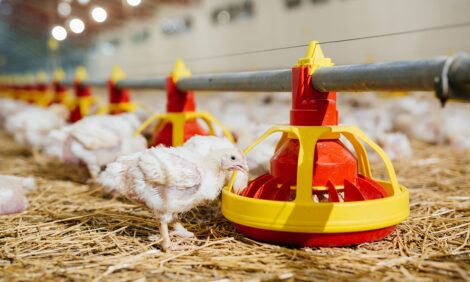



Investigation of Eggshell Apex Abnormalities in Great Britain
Eggshell Apex Abnormalities (EAA) have been reported in the Netherlands, Italy and recently also in the UK. According to Defra in a review of current knowledge in this area, EAA lesions have been associated in the field with infection by certain strains of Mycoplasma.A case of suspected Eggshell Apex Abnormalities (EAA) was investigated in a flock of 14,000 free-range layer chickens in Great Britain as part of AHVLA’s scanning surveillance programme. EAA was first identified approximately 10 years ago in the Netherlands affecting layer flocks, and has been more recently reported in Italy. There have been no prior reported detections in Great Britain, although there are anecdotal reports of suspected EAA cases. The condition is not known to pose any threat to public health or have any impact on international trade.

Note the collapsed egg shell apex as a result of thinning of the shell in this region, and the clear demarcation between normal and abnormal shell
What is EAA?
The term ‘EAA’, also known as ‘glass top eggs’, refers to a characteristic egg shell lesion, comprising a well demarcated region of thin, soft shell at the apex (or sharp end) of an affected egg. This abnormal shell may be easily broken (Figures 1a and 1b). EAA lesions have been associated in the field with infection of the hen’s oviduct by certain strains of Mycoplasma synoviae (Ms) resulting in the production of abnormal eggs. Recent experimental studies have reproduced the condition by infecting laying hens with Infectious Bronchitis virus (IBV) and certain strains of M. synoviae. Reasonable protection was also demonstrated with a live MS vaccine.
One hypothesis is that certain strains of Ms might have a tropism for the hen’s reproductive tract, where colonisation (under some circumstances) leads to the production of abnormal eggs with EAA. However, although very distinctive, the eggshell lesions may not be necessarily pathognomonic for any pathogen or combination of pathogens.
In chickens, other endemic conditions caused by Ms (joint disease and/or subclinical respiratory tract infections) are well described. Conversely, EAA is a relatively novel condition. The range of abnormal egg production can vary from one to two per cent up to 25 per cent in an EAA-affected flock, and typically continues for the remainder of the laying period following onset. Affected flocks may be depleted early if they become financially unviable.
AHVLA Investigation
AHVLA is raising initial awareness among Defra, AHVLA and SAC laboratories and private veterinary surgeons (PVSs) in practice. This has also included liaison with colleagues in The Netherlands (GD Deventer) to benefit from their experiences and expertise. When investigations are concluded, AHVLA will disseminate further information to PVSs and the poultry industry about this new risk.
For further information about eggshell apex abnormalities and useful references, please click on the links below:
- Information from Defra for farmers and vets in GB
- Strugnell and others Unusual eggshell defects in a free range layer flock in GB. Veterinary Record (2001) 169:237-238. doi:10.1136/vr.d5430
Further Reading
| - | Find out more information on the diseases mentioned in this article by clicking here. |
December 2011








